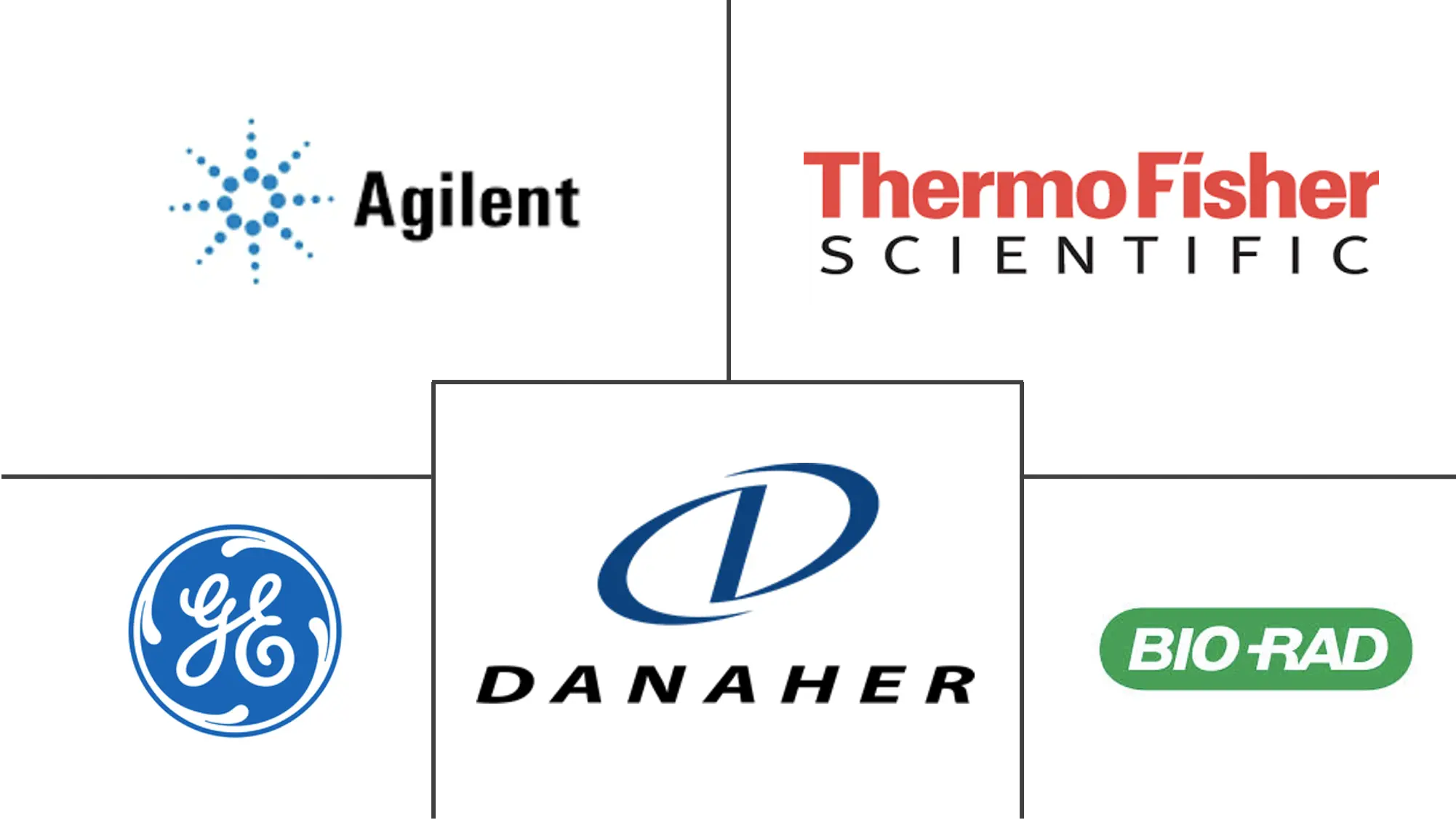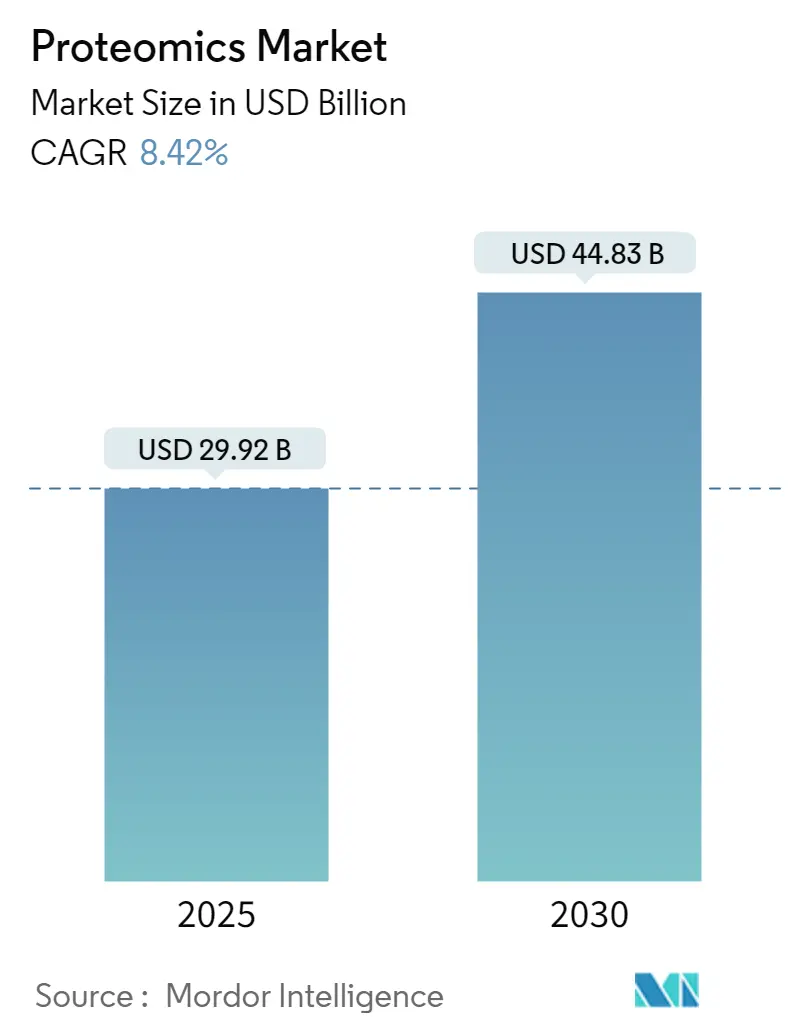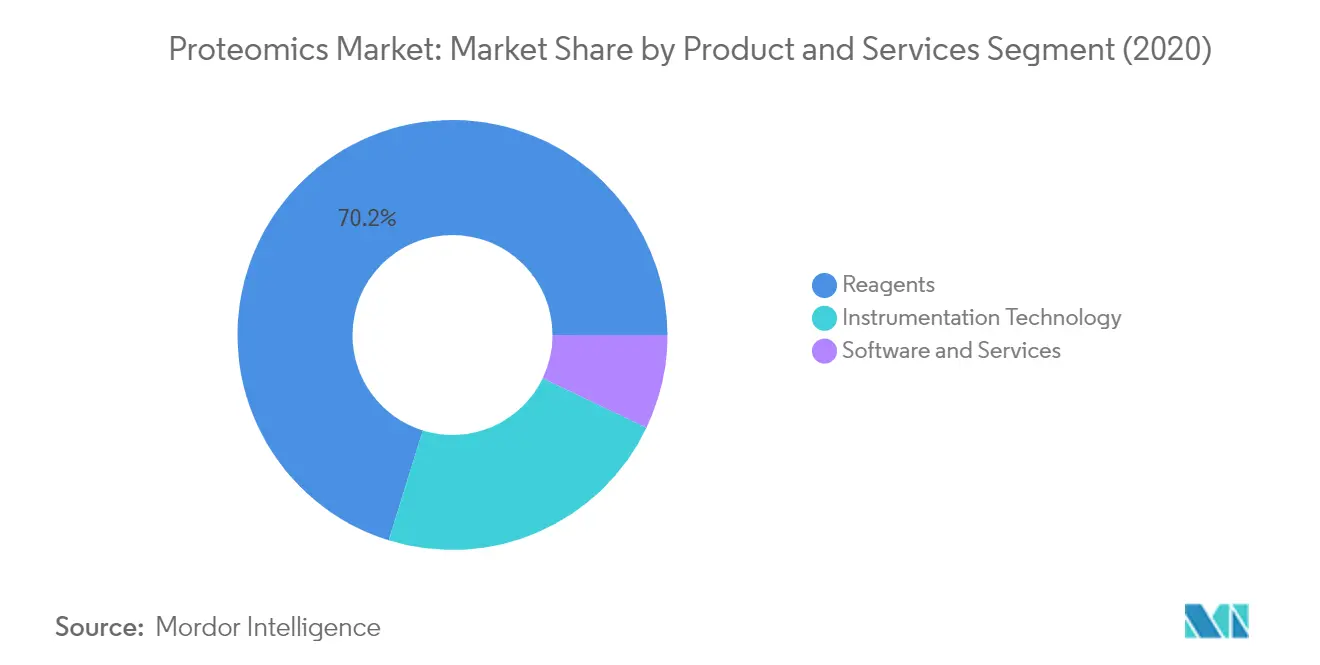Proteomics Market Analysis
The Proteomics Market size is estimated at USD 29.92 billion in 2025, and is expected to reach USD 44.83 billion by 2030, at a CAGR of 8.42% during the forecast period (2025-2030).
The proteomics industry is experiencing significant transformation driven by increasing investment activity and the emergence of innovative proteomics companies. This evolution is particularly evident in the venture capital landscape, where proteomics-focused companies are attracting substantial funding. A notable example is Alamar Biosciences, which secured USD 80 million in Series B financing in September 2021, bringing its total funding to USD 110 million with backing from prominent investors including Sherpa Healthcare Partners and Morningside Ventures. Similarly, A-Alpha Bio, a company specializing in protein interaction testing, received USD 20 million in funding to expand its capabilities, demonstrating strong investor confidence in proteomics technologies.
Strategic partnerships and collaborations have become increasingly crucial in advancing proteomics research and applications. Companies are recognizing that the complexity of proteomics research requires diverse expertise and capabilities that often cannot be found under a single roof. This trend is exemplified by the collaboration between Biognosys and Evotec in September 2021, which aimed to integrate next-generation proteomics data analysis platforms in drug discovery and clinical research. These partnerships are particularly focused on combining complementary technologies and expertise to accelerate innovation and market development.
The market is witnessing a significant shift towards integrated solutions that combine multiple analytical technologies. Mass spectrometry manufacturers are increasingly collaborating with protein chip companies to develop comprehensive analytical solutions. This integration is creating new opportunities for more efficient and accurate protein analysis, enabling researchers to gain deeper insights into protein structures and interactions. The trend towards integration is also driving the development of more sophisticated data management and analysis tools, as the volume and complexity of proteomics data continue to grow.
The market is characterized by rapid technological evolution, particularly in areas such as protein interaction analysis and structural proteomics. Recent advances in neuroscience applications demonstrate the expanding scope of proteomics, with new techniques being developed for protein labeling in specific brain regions. These developments are particularly significant for understanding neurodegenerative disorders and developing early diagnostic capabilities. The industry is also seeing increased focus on data management solutions, with companies investing in advanced analytical platforms that can handle the complex data generated by proteomics research.
Proteomics Market Trends
Rising Demand for Personalized Medicine
Precision medicine, also known as personalized medicine, has emerged as a revolutionary approach in healthcare that tailors medical treatment to individual patient characteristics. The field of proteomics holds immense promise in advancing personalized medicine through its unique capabilities in biomarker discovery and therapeutic target identification. According to the National Institutes of Health (NIH) data, an estimated 1,806,590 new cases of cancer were diagnosed in the United States, highlighting the critical need for personalized treatment approaches. Proteomics enables scientists to screen large numbers of proteins within clinically distinct samples, facilitating the discovery of disease biomarkers and identification of drug targets.
The integration of proteomics in precision medicine has revolutionized the ability to predict and differentiate disease diagnoses, providing better therapy responses and reducing illness severity. Proteomics combines molecular information of patients instead of adhering to generic treatment protocols, enabling healthcare providers to detect diseases at primary stages and increasing the efficiency, quality, and accessibility of care. The technology's capability to perform comprehensive molecular characterization of tumors has become the most promising therapeutic strategy for cancer treatment, allowing for targeted drug therapies while minimizing side effects and improving efficacy.
Increasing R&D Expenditure and Government Funding for Proteomics
The pharmaceutical and biotechnology sectors have demonstrated substantial commitment to advancing proteomics research through increased R&D investments. According to the Pharmaceutical Research and Manufacturers of America (PhRMA), member companies invested $83 billion in R&D activities, establishing the biopharmaceutical sector as the most R&D-intensive industry in the US economy. This significant investment has enabled the development of innovative technologies in proteomics, including improvements in bioinformatics, protein arrays, and nanotechnology solutions for protein analysis. The National Cancer Institute's (NCI) Small Business Innovation Research (SBIR) Development Center has implemented strategic grant programs to support protein-based research activities, providing opportunities for developing proteomics technologies for untargeted discovery of the proteome in single cells.
The surge in research funding has catalyzed numerous collaborative initiatives between academic institutions, research centers, and industry partners. These partnerships have created a conducive environment for breakthrough discoveries in membrane protein characterization and other critical areas of proteomics research. The increasing prevalence of cardiovascular diseases and modern lifestyle-related health conditions has prompted pharmaceutical companies to invest in effective methods for drug delivery, ensuring greater traction for membrane protein characterization. This has led to a higher R&D focus and a predicted rise in both investment and government incentives, creating an environment conducive to innovation in proteomics research and development.
Technological Advancements
The proteomics field has witnessed remarkable technological innovations, driven by continuous investments from companies, government institutions, and research centers. These advancements have significantly improved the efficiency and accuracy of protein analysis, enabling researchers to generate more comprehensive and detailed insights into protein structures and functions. Pharmaceutical companies are ensuring the launch of products with technological advancements to increase their revenue share, focusing on cost-effective solutions that drive proteomics market growth. For instance, the development of high-sensitivity mass spectrometry systems and advanced chromatography techniques has revolutionized protein identification and quantification capabilities.
Partnerships and collaborations have become increasingly crucial in the proteomics field, as it is challenging for companies to find all necessary expertise under one umbrella to cover the diverse activities involved in proteomics research. Many companies working with mass spectrometry, both manufacturers and end-user labs, are collaborating with protein chip-related companies to enhance cost-effectiveness and efficiency in proteomics research. The integration of artificial intelligence and machine learning with proteomics technologies has further accelerated the pace of innovation, enabling faster data analysis and more accurate protein characterization. These technological advancements have significantly improved the ability to study protein interactions, modifications, and functions, leading to more effective drug discovery and development processes.
Segment Analysis: By Product and Services
Reagents Segment in Proteomics Market
The proteomics reagents segment dominates the global proteomics market, commanding approximately 70% of the total market share in 2024. This segment encompasses a comprehensive range of products, including assay reagents, sample preparation reagents, protein sequencing reagents, protein electrophoresis reagents, and various control solutions and kits essential for protein analysis and applications. The segment's dominance can be attributed to the continuous and high-volume consumption of these products in both research and industrial applications, coupled with their critical role in protein analysis, function studies, and structural investigations. The increasing adoption of protein-related products in daily life and extensive use of proteomics reagents for quality control and research purposes have further solidified this segment's market leadership. Additionally, the growing awareness about proteomics and intensifying research activities have prompted companies to focus more resources on reagent development and innovation.
Software and Services Segment in Proteomics Market
The software and services segment in the proteomics market is experiencing significant transformation driven by technological advancements in bioinformatics and data analysis capabilities. This segment is witnessing substantial growth as the analysis of large proteomics datasets becomes increasingly complex and requires sophisticated computational tools. The segment's expansion is fueled by the rising demand for advanced analytical technologies at research institutes and the growing need for efficient data interpretation solutions. Service providers are continuously expanding their offerings to include protein quantification, purification, isolation, expression analysis, and other specialized services for customers lacking appropriate resources for complete proteomics studies. The integration of artificial intelligence and machine learning in proteomics software solutions is further accelerating market growth, enabling more accurate and faster analysis of complex protein data.
Remaining Segments in Product and Services
The instrumentation technology segment plays a vital role in the proteomics market, encompassing various essential technologies such as spectroscopy, chromatography, electrophoresis, protein microarrays, and X-ray crystallography. This segment serves as the backbone of proteomics research by providing the necessary tools and equipment for protein analysis and characterization. The continuous advancement in instrumentation technologies, particularly in mass spectrometry and protein microarray platforms, has significantly enhanced the capabilities of protein analysis and identification. These technological improvements have led to more accurate and efficient protein analysis, enabling researchers to better understand protein structures, functions, and interactions in biological systems.
Segment Analysis: By Application
Drug Discovery Segment in Proteomics Market
The drug discovery segment dominates the global proteomics market, accounting for approximately 49% of the total market share in 2024. This segment's prominence is driven by the extensive application of proteomics in multiple stages of the drug discovery pipeline, including target identification and evaluation, biomarker identification, and investigations into drug action mechanisms. Proteomics combines aspects of biology, chemistry, engineering, and information science to enable scientists to screen large numbers of proteins within clinically distinct samples, helping to discover disease biomarkers, identify and validate drug targets, design more effective drugs, and assess drug efficacy and patient response in a very short span of time. The segment's growth is further bolstered by the increasing focus on personalized medicine and the rising demand for targeted therapies. Pharmaceutical and biotechnology companies are extensively utilizing proteomic technologies for comprehensive molecular characterization of tumors and other diseases, making it an indispensable tool in modern drug development processes.
Clinical Diagnostics Segment in Proteomics Market
The clinical diagnostics segment represents a significant portion of the proteomics market, with its applications spanning across disease detection, identification, and quantification of protein content in samples for diagnosis and prognosis. This segment is witnessing substantial growth due to the increasing adoption of proteomics-based diagnostic approaches in healthcare settings. The advancement in proteomics technologies has enabled more accurate and efficient diagnostic processes, particularly in areas such as cancer detection, cardiovascular diseases, and rare genetic disorders. The segment's expansion is further supported by the growing demand for early disease detection and personalized treatment approaches, along with the increasing integration of proteomic technologies in clinical laboratories worldwide.
Remaining Segments in Application Market Segmentation
Other applications in the proteomics market encompass diverse areas including food science, agriculture, systems biology, and paleo-proteomics. In the food sciences industry, proteomics plays a crucial role in food safety and quality control analysis, along with improving the nutritional value of food materials. In agriculture, proteomics is utilized for studying plant-pathogen interactions and developing genetically engineered plants resistant to environmental stress factors. These applications continue to expand as new use cases emerge across different industries, contributing to the overall growth of the proteomics market while opening new avenues for research and development.
Proteomics Market Geography Segment Analysis
Proteomics Market in North America
North America represents a dominant force in the global proteomics market, driven by advanced healthcare infrastructure, substantial research and development activities, and a strong presence of major market players. The United States leads the regional proteomics market, followed by Canada and Mexico. The region's growth is supported by increasing demand for personalized medicine, rising government funding for proteomics research, and continuous technological advancements in the field. The presence of well-established research institutions and biotechnology companies further strengthens the market position of North America in the global proteomics landscape.
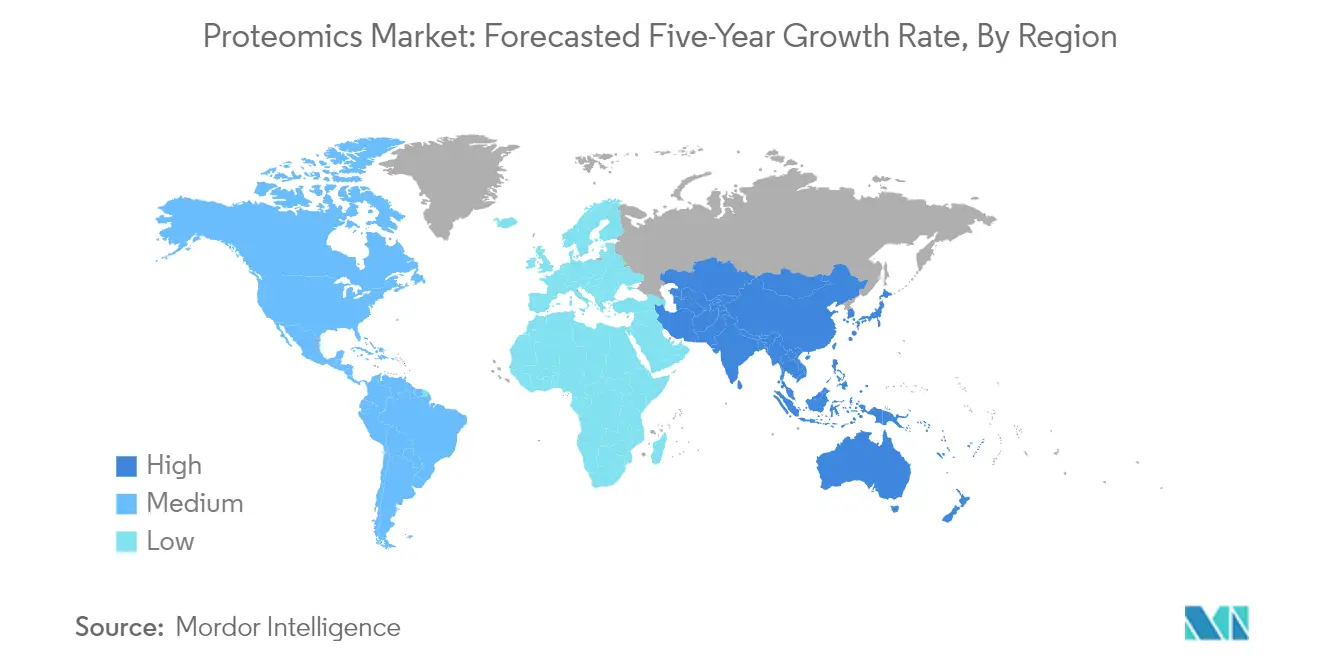
Proteomics Market in the United States
The United States dominates the North American proteomics market, accounting for approximately 85% of the regional market share in 2024. The country's market leadership is attributed to its robust healthcare system, substantial investments in research and development, and the presence of leading biotechnology companies. The US market benefits from significant government funding through organizations like the National Institutes of Health (NIH) and various research grants. The country's focus on precision medicine initiatives, coupled with increasing adoption of advanced proteomics technologies in drug discovery and development, continues to drive market growth.
Proteomics Market in Canada
Canada emerges as the fastest-growing market in North America, with a projected growth rate of approximately 9% during 2024-2029. The country's proteomics market is experiencing rapid expansion due to increasing investments in healthcare infrastructure and a rising focus on biomedical research. Canada's universal healthcare system and strong academic research networks contribute significantly to market growth. The country's emphasis on modernizing healthcare infrastructure and a growing biopharmaceutical sector, supported by government initiatives and private sector investments, positions it well for continued growth in the proteomics market.
Proteomics Market in Europe
Europe represents a significant market for proteomics, characterized by strong research infrastructure, technological innovation, and increasing healthcare expenditure. The region's market is driven by countries like Germany, France, the United Kingdom, Italy, and Spain, each contributing significantly to the overall market growth. The European market benefits from robust academic-industry collaborations, substantial research funding, and growing adoption of advanced proteomics technologies in both clinical and research settings.
Proteomics Market in Germany
Germany leads the European proteomics market, commanding approximately 24% of the regional market share in 2024. The country's dominant position is supported by its strong base of global companies working in proteomics, extensive research and development activities, and high adoption rates by pharmaceutical industries. Germany's leadership in the market is further strengthened by its advanced healthcare infrastructure, significant investment in biotechnology research, and the presence of leading research institutions focusing on proteomics applications.
Proteomics Market in Germany - Growth Analysis
Germany also emerges as the fastest-growing market in Europe, with an expected growth rate of approximately 11% during 2024-2029. The country's rapid growth is driven by increasing investment in research and development, a growing focus on personalized medicine, and continuous technological advancements. The presence of well-established facilities equipped with state-of-the-art technologies and strong government support for research initiatives contributes to this growth trajectory. Germany's commitment to innovation and research excellence continues to attract investments and partnerships in the proteomics sector.
Proteomics Market in Asia-Pacific
The Asia-Pacific region represents a rapidly evolving market for proteomics, characterized by increasing research activities, growing healthcare infrastructure, and rising investments in biotechnology. Countries like China, Japan, India, Australia, and South Korea are key contributors to the regional market growth. The region benefits from growing government support for research and development, increasing healthcare expenditure, and rising awareness about advanced diagnostic technologies.
Proteomics Market in China
China leads the Asia-Pacific proteomics market, driven by substantial investments in healthcare infrastructure and research facilities. The country's market leadership is attributed to its large patient population, increasing R&D expenditure, and a growing focus on personalized medicine. China's commitment to advancing its biotechnology sector, coupled with rising government support for research initiatives, continues to strengthen its position in the regional market.
Proteomics Market in China - Growth Analysis
China maintains its position as the fastest-growing market in the Asia-Pacific region, driven by rapid technological adoption and increasing research activities. The country's growth is supported by rising demand for advanced diagnostic technologies, growing investment in healthcare infrastructure, and an expanding biotechnology sector. China's focus on developing innovative proteomics solutions and increasing collaboration between academic institutions and industry players contributes to its rapid market expansion.
Proteomics Market in the Middle East & Africa
The Middle East & Africa region presents an emerging market for proteomics, with growing potential in research and clinical applications. The market encompasses key regions including GCC countries and South Africa, with varying levels of healthcare infrastructure and research capabilities. Within this region, GCC countries lead the market size due to their robust healthcare infrastructure and increasing investments in research and development, while South Africa shows the fastest growth potential driven by expanding research activities and increasing adoption of advanced diagnostic technologies.
Proteomics Market in South America
The South American proteomics market demonstrates steady growth potential, with Brazil and Argentina as key contributing countries. The region's market is characterized by increasing investment in healthcare infrastructure, growing research activities, and rising adoption of advanced diagnostic technologies. Brazil emerges as both the largest and fastest-growing market in the region, supported by its extensive research infrastructure and increasing focus on biotechnology development. The region's market growth is further driven by rising healthcare expenditure and growing awareness about advanced diagnostic technologies.
Proteomics Industry Overview
Top Companies in Proteomics Market
The proteomics market features several prominent players, including Thermo Fisher Scientific, Danaher Corporation, Agilent Technologies, Bio-Rad Laboratories, and Waters Corporation, among others. These proteomics companies demonstrate a strong commitment to innovation through the continuous development of advanced mass spectrometry systems, chromatography solutions, and protein analysis platforms. Market leaders are increasingly focusing on expanding their technological capabilities through strategic collaborations with research institutions and biotechnology firms. Operational excellence programs and manufacturing optimization initiatives are being implemented to enhance production efficiency and reduce costs. Companies are also pursuing geographic expansion, particularly in emerging markets, while simultaneously strengthening their presence in established regions through enhanced distribution networks and customer support services. The competitive landscape is characterized by significant investments in research and development, with companies regularly introducing new products and solutions to address evolving customer needs in proteomics research and applications.
Consolidated Market with Strong Growth Potential
The proteomics market structure exhibits a relatively consolidated nature, dominated by large multinational corporations with comprehensive product portfolios spanning multiple technology platforms. These established players leverage their extensive research capabilities, global distribution networks, and strong financial positions to maintain market leadership. The market witnesses regular merger and acquisition activities as companies seek to expand their technological capabilities and geographic reach. Smaller specialized firms often become acquisition targets for larger companies looking to enhance their product offerings or enter specific market segments. Regional players maintain their presence through a focus on specific geographic markets or specialized product niches.
The competitive dynamics are shaped by high entry barriers due to significant capital requirements, technical expertise needs, and regulatory compliance demands. Market leaders continuously strengthen their positions through vertical integration strategies, encompassing everything from instrument manufacturing to after-sales services. Strategic partnerships and collaborations between companies, academic institutions, and research organizations are common, fostering innovation and market expansion. The proteomics industry also sees the emergence of new entrants, particularly in specialized segments or emerging technologies, though they often face challenges in scaling their operations to compete with established players.
Innovation and Adaptability Drive Market Success
Success in the proteomics market increasingly depends on companies' ability to innovate while maintaining operational efficiency. Market leaders must focus on developing integrated solutions that combine hardware, software, and services to provide comprehensive proteomics research capabilities. Companies need to invest in next-generation technologies while ensuring backward compatibility with existing systems. Customer relationship management and technical support capabilities are becoming increasingly important as end-users seek reliable, long-term partnerships. Regulatory compliance and quality assurance remain critical factors, particularly in pharmaceutical and clinical applications.
For emerging players and market contenders, success lies in identifying and focusing on specific market niches or technological innovations that address unmet needs. Companies must develop strategies to navigate the high concentration of end-users in academic and pharmaceutical sectors while building strong value propositions. The risk of substitution remains relatively low due to the specialized nature of proteomics technologies, but companies must stay ahead of technological advances. Future success will depend on the ability to adapt to evolving regulatory requirements, particularly in clinical applications, while maintaining cost competitiveness and service quality. Building strong intellectual property portfolios and establishing strategic partnerships will be crucial for long-term success in this market.
Proteomics Market Leaders
-
Agilent Technologies, Inc.
-
Bio-Rad Laboratories, Inc.
-
Thermo Fisher Scientific, Inc.
-
Danaher Corporation
-
GE Healthcare
- *Disclaimer: Major Players sorted in no particular order
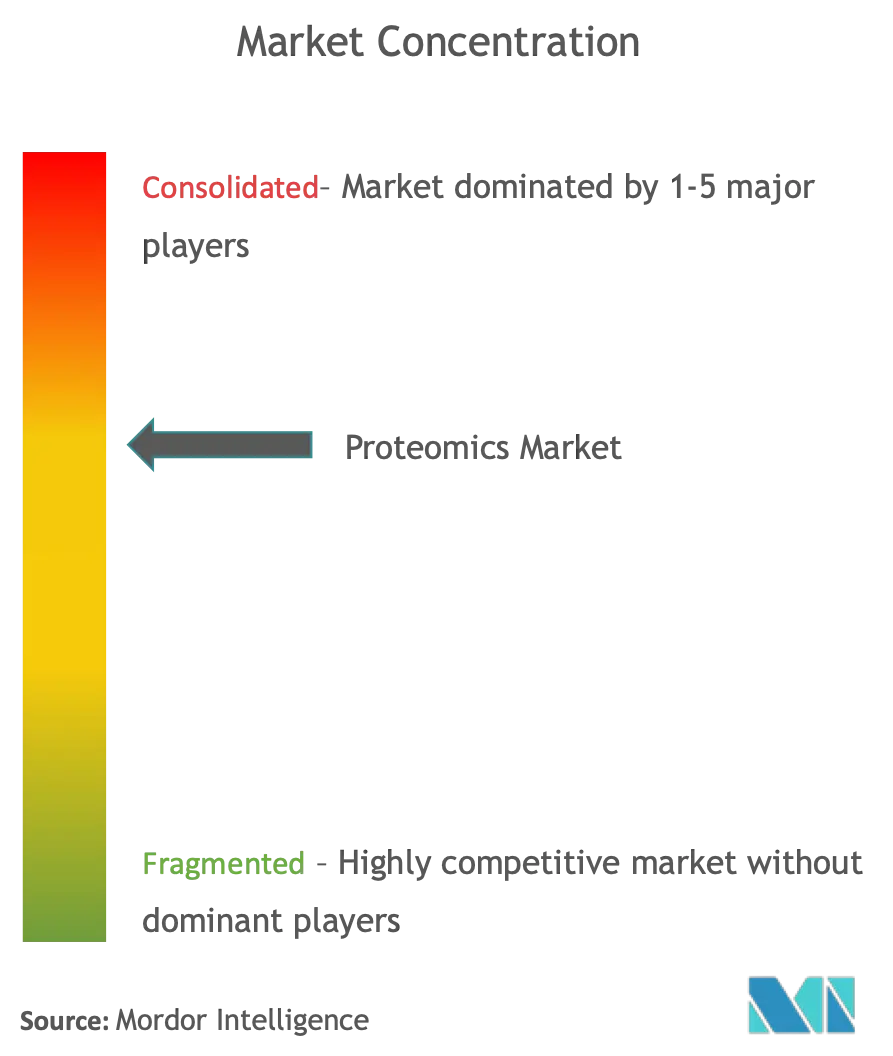
Proteomics Market News
In Feb 2021, Agilent Technologies Inc. launched Agilent Dako SARS-CoV-2 IgG Enzyme-Linked Immunosorbent Assay (ELISA) kit intended for the qualitative detection of immunoglobulin G (IgG) antibodies to SARS-CoV-2 in human serum or plasma.
In Dec 2020, Thermo Fisher Scientific, acquired Phitonex, Inc. Phitonex's product offering will enable Thermo Fisher to offer greater flow cytometry and imaging multiplexing capabilities to meet evolving customer needs in protein and cell analysis research.
Proteomics Market Report - Table of Contents
1. INTRODUCTION
- 1.1 Study Deliverables
- 1.2 Study Assumptions
- 1.3 Scope of the Study
2. RESEARCH METHODOLOGY
3. EXECUTIVE SUMMARY
4. MARKET DYNAMICS
- 4.1 Market Overview
-
4.2 Market Drivers
- 4.2.1 Rising Demand for Personalized Medicine
- 4.2.2 Increasing R&D Expenditure and Government Funding for Proteomics
- 4.2.3 Technological Advancements
-
4.3 Market Restraints
- 4.3.1 High Cost of Instruments
-
4.4 Porter's Five Forces Analysis
- 4.4.1 Threat of New Entrants
- 4.4.2 Bargaining Power of Buyers/Consumers
- 4.4.3 Bargaining Power of Suppliers
- 4.4.4 Threat of Substitute Products
- 4.4.5 Intensity of Competitive Rivalry
5. MARKET SEGMENTATION
-
5.1 By Product & Services
- 5.1.1 Instrumentation Technology
- 5.1.1.1 Spectroscopy
- 5.1.1.2 Chromatography
- 5.1.1.3 Electrophoresis
- 5.1.1.4 Protein Microarrays
- 5.1.1.5 X-Ray Crystallography
- 5.1.1.6 Other Instrumentation Technologies
- 5.1.2 Reagents
- 5.1.3 Software and Services
-
5.2 By Application
- 5.2.1 Clinical Diagnostics
- 5.2.2 Drug Discovery
- 5.2.3 Other Applications
-
5.3 Geography
- 5.3.1 North America
- 5.3.1.1 United States
- 5.3.1.2 Canada
- 5.3.1.3 Mexico
- 5.3.2 Europe
- 5.3.2.1 Germany
- 5.3.2.2 United Kingdom
- 5.3.2.3 France
- 5.3.2.4 Italy
- 5.3.2.5 Spain
- 5.3.2.6 Rest of Europe
- 5.3.3 Asia-Pacific
- 5.3.3.1 China
- 5.3.3.2 Japan
- 5.3.3.3 India
- 5.3.3.4 Australia
- 5.3.3.5 South Korea
- 5.3.3.6 Rest of Asia-Pacific
- 5.3.4 Middle-East & Africa
- 5.3.4.1 GCC
- 5.3.4.2 South Africa
- 5.3.4.3 Rest of Middle-East & Africa
- 5.3.5 South America
- 5.3.5.1 Brazil
- 5.3.5.2 Argentina
- 5.3.5.3 Rest of South America
6. COMPETITIVE LANDSCAPE
-
6.1 Company Profiles
- 6.1.1 Agilent Technologies, Inc.
- 6.1.2 Bio-Rad Laboratories, Inc.
- 6.1.3 Bruker Corporation
- 6.1.4 Danaher Corporation
- 6.1.5 GE Healthcare
- 6.1.6 Merck KGaA
- 6.1.7 Promega Corporation
- 6.1.8 Thermo Fisher Scientific, Inc.
- 6.1.9 Waters Corporation
- *List Not Exhaustive
7. MARKET OPPORTUNITIES AND FUTURE TRENDS
Proteomics Industry Segmentation
Proteomics is the study of protein structure and function. At the cellular level, proteomics deal with the topics, such as which proteins are expressed, when and where they are expressed, what their structures in both active and inactive states are, what roles they play in the life of the cell, and how they interact with other proteins and molecules.
| By Product & Services | Instrumentation Technology | Spectroscopy | |
| Chromatography | |||
| Electrophoresis | |||
| Protein Microarrays | |||
| X-Ray Crystallography | |||
| Other Instrumentation Technologies | |||
| Reagents | |||
| Software and Services | |||
| By Application | Clinical Diagnostics | ||
| Drug Discovery | |||
| Other Applications | |||
| Geography | North America | United States | |
| Canada | |||
| Mexico | |||
| Europe | Germany | ||
| United Kingdom | |||
| France | |||
| Italy | |||
| Spain | |||
| Rest of Europe | |||
| Asia-Pacific | China | ||
| Japan | |||
| India | |||
| Australia | |||
| South Korea | |||
| Rest of Asia-Pacific | |||
| Middle-East & Africa | GCC | ||
| South Africa | |||
| Rest of Middle-East & Africa | |||
| South America | Brazil | ||
| Argentina | |||
| Rest of South America | |||
Proteomics Market Research FAQs
How big is the Proteomics Market?
The Proteomics Market size is expected to reach USD 29.92 billion in 2025 and grow at a CAGR of 8.42% to reach USD 44.83 billion by 2030.
What is the current Proteomics Market size?
In 2025, the Proteomics Market size is expected to reach USD 29.92 billion.
Who are the key players in Proteomics Market?
Agilent Technologies, Inc., Bio-Rad Laboratories, Inc., Thermo Fisher Scientific, Inc., Danaher Corporation and GE Healthcare are the major companies operating in the Proteomics Market.
Which is the fastest growing region in Proteomics Market?
Asia Pacific is estimated to grow at the highest CAGR over the forecast period (2025-2030).
Which region has the biggest share in Proteomics Market?
In 2025, the North America accounts for the largest market share in Proteomics Market.
What years does this Proteomics Market cover, and what was the market size in 2024?
In 2024, the Proteomics Market size was estimated at USD 27.40 billion. The report covers the Proteomics Market historical market size for years: 2019, 2020, 2021, 2022, 2023 and 2024. The report also forecasts the Proteomics Market size for years: 2025, 2026, 2027, 2028, 2029 and 2030.
Our Best Selling Reports
Proteomics Market Research
Mordor Intelligence provides comprehensive insights into the rapidly evolving proteomics industry. We offer expert market analysis and consulting services. Our extensive research covers the complete spectrum of protein analysis technologies. This includes advanced genomics proteomic tools and emerging proteomic biomarker applications. The report delivers a detailed analysis of leading proteomics companies and their strategic initiatives. This is supported by our robust research methodology and industry expertise.
This detailed market study offers stakeholders valuable insights into proteomics market size projections and proteomics market growth trajectories. It also includes an in-depth proteomics market trends analysis. The report, available as a downloadable PDF, includes comprehensive proteomics market research data. This enables businesses to make informed decisions in this dynamic sector. Our analysis encompasses various segments, including proteomic kits and proteomics instrument developments. This provides stakeholders with actionable intelligence for strategic planning and investment decisions.

